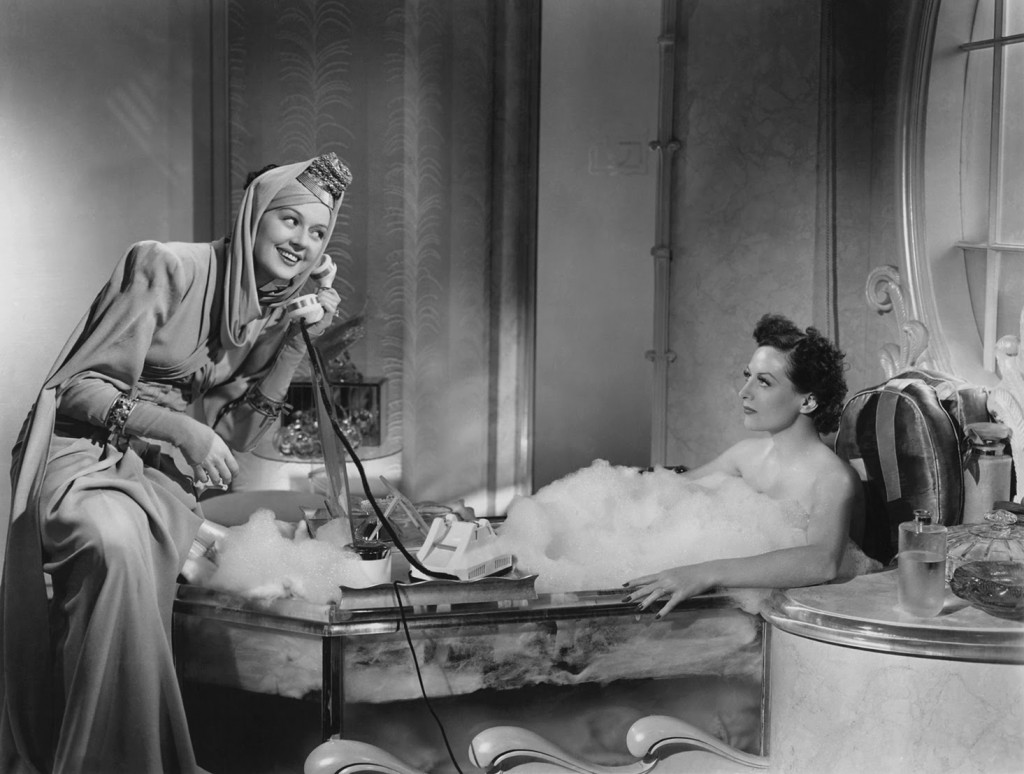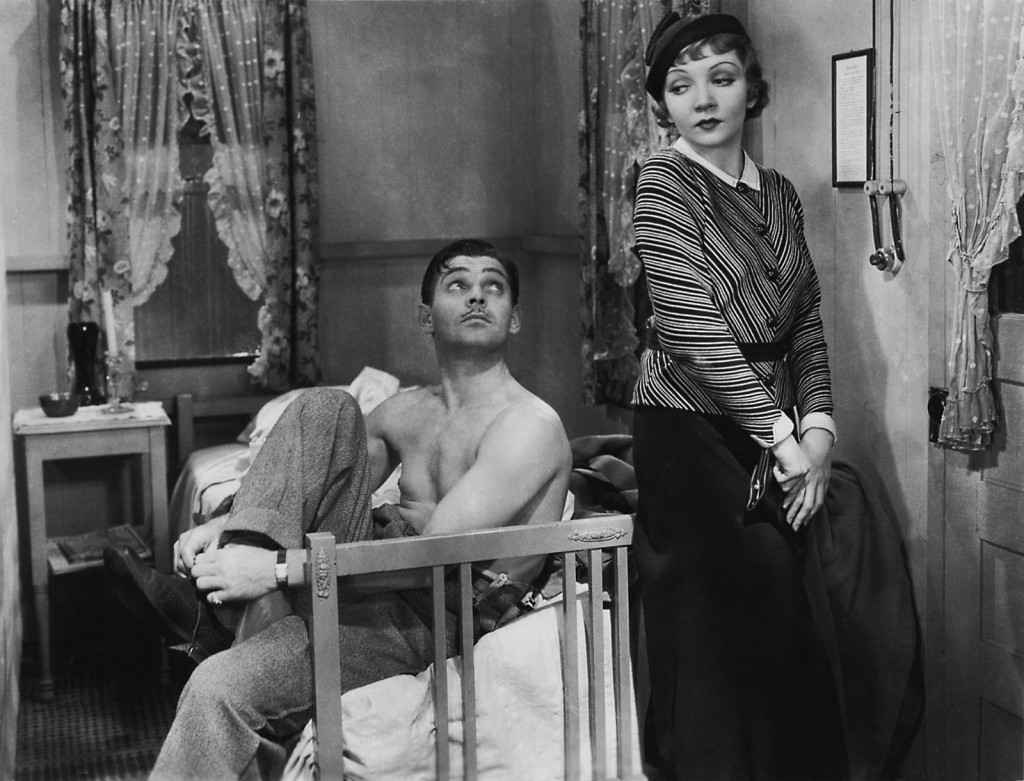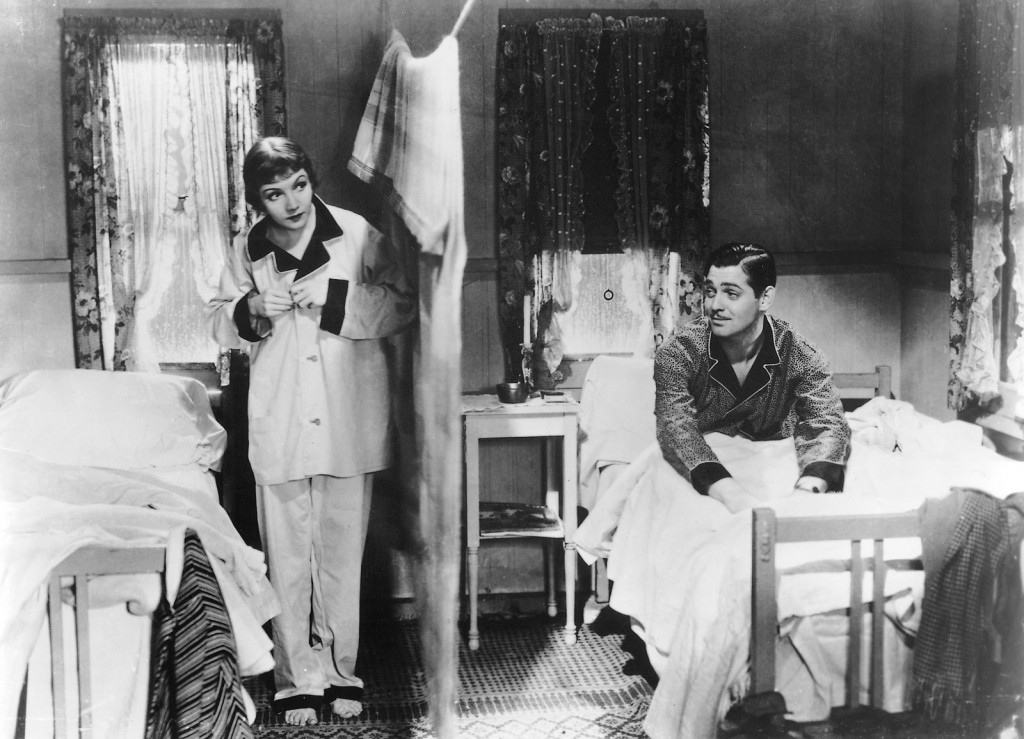So this image was annotated with the actor names (and links to their Wikipedia bios) in Thinglink, embedded in the post, and then, AND THEN, I could annotated it further from within the post (the comment about the wedding ring). AND THEN, my annotation updated on Thinglink, and my edits to annotations on Thinglink updated on this post. So much potential here.
Author: JJ Bauer (Page 2 of 2)
The above quote comes from Baby Face (1933), a “Pre-Code” Hollywood film starring Barbara Stanwyck that embraced Nietszche and exploitation as a primary means of Depression era survival. This did not go over so well with the newly empowered MPPDA, who upon enforcing their Production Code in 1934 required that any re-release of this film have the offending Nietszche material cut out and replaced by a new voice-over containing a moralizing lecture (and at least an implication that the book in the scene is a Bible, rather than the writing of Nietszche). No master and slave power dynamic and more a cautionary “there is a right way and a wrong way” for Lily Powers to get along in the world.
I think this is an appropriate choice for today’s workshop response, since we were tasked in the afternoon with “exploiting” one of three free content management systems–Drupal, Omeka, and Scalar–to see if one of them would suit our particular project. And because I tested Scalar using the above offending scene, creating a film and censorship project (still private, but also with all of one page and 2 media items in it, so not that interesting to the outside observer yet). I was attracted to Scalar because it was designed specifically to be used with multimedia projects using images, video, sound, etc, because a lot of those kinds of files could be linked in from outside sources (so not having to have a lot of server space built in for large media files), but also because, as I said to my other Scalar-testing colleagues at the table, it is rather like a “Choose Your Own Adventure” book, based on nodes and paths but not requiring a linear structure and including other visualization techniques to link data within the project.
Scalar was somewhat the reverse of my experience working with other CMS or blogging tools like WordPress, in that it required me to ingest or link to my media first and then build pages, comments, notes and annotations around that media second. Easy enough to re-orient myself to, and also not requiring me to have a grand plan or structure from the start. And the annotations and tags are truly wonderful. I could annotate my video clip, starting at the moment where the cobbler invokes the great philosopher and ending with Lily’s thoughtful “huh” (notice the clip above is just pulled in from Youtube and has no annotations). The annotation could include detailed text explaining why I made that particular choice (Here Be Voice-Over after The Code!) which would pop-up under the playback of the video when it came to the annotation starting point. Tags could be anything I want, and would be created as a page within my project, which meant that I could Tag any media object or other page, as well as add further explanatory information, links, bibliography or notes to the Tag itself–my first tag was “Pre-Code” and I can see how that could use some defining for audiences not familiar with the brief period from 1930-1934 when the MPPDA had a written censorship code but the studio members really didn’t make any attempt to enforce said self-produced code until further threats of Catholic boycotts forced them to finally capitulate and set up an office that would police the industry until 1968. I could add links to wikipedia, PDFs, and more. And, with more items tagged, and more tags, I could very easily look at my project as a network visualization (tags are links, lots of mentions in tags would mean sizeable nodes), showing how censorship could cross studios, films, actors, genres, gender, or any other grouping that would change the mostly linear and anecdotal story of film censorship in current scholarship. And I could see all of this potential after only an hour-and-a-half of work, which was even more exciting, especially if I am hoping to have students engage with this tool for a course assignment.
The plan for tomorrow during the workshop (#doingdah14) is to strategize about the kind of collection building or utilizing that will be necessary to form the foundations of our projects. This I know, as a Visual Resources Curator who has been engaged in image repository building for over 10 years. But this is also where I feel like my particular project, centered as it is on commercial Hollywood films, is also behind the eight ball. The eight ball being the MPAA in its lobbying form, which has worked to make copyright for film so restrictive that many scholars who work in film studies can’t even obtain the appropriate film still photography to accompany their arguments in books and essays because the film studios who own and distribute that material just don’t feel like making those stills available to you, “but here is a set photograph of a totally different moment in the film that you can have because we already had that one ready to go.”
For teaching, the situation is somewhat better relative to copyright. Because of fair use, and in particular because of specific language written into the DMCA of 1998, I can show brief chosen film clips or whole films in my courses. However, my students have to check out DVDs from our extremely supportive but hamstrung Media Resources Center (2 copies on reserve per course), or rely on their own private Netflix accounts to watch full films, and the ongoing UCLA legal case regarding streaming films for a course leaves undetermined the consequences if I should choose to make a film available for streaming on my own through the course management system (Blackboard or Sakai or the like). And very few online repositories are engaging in film collection building beyond what is already available in the public domain. There I have options, usually the best being the Internet Archive. Silent films I can have access to online. Everything else is questionable. And potentially illegal or expensive or unsustainable (I wonder how many people know that films currently on Netflix might not still be there tomorrow. And how efficient is it to have to access whole films rather than the specific clips you wish to analyze and read closely?)
There is always Youtube. Films uploaded in ten-minute increments of terrible quality (HD is now becoming somewhat more common) and of questionable legality because a single take-down notice from MGM (or more likely Turner Entertainment Co., who owns the MGM back catalog) can get it removed instantly and the onus is on the uploader to prove their fair use to get it put back again.
So part of my project is to again grapple with collection building of a very different type. To utilize multimedia CMS platforms such as Omeka or Scalar, and repository storage sites like the Critical Commons in order to compile many examples of moments, scenes, comparisons across films, across genres, across eras, in the way that makes the most sense for film studies, as they play out over time. Use fair use to bolster my case as for why a repository that includes a 3-minute clip of Joan Crawford taking a bath in The Women (1939) is neither an excessive excerpt nor adequately substituted for analysis and pedagogy by a still image. And hope that it can prove useful for wider public engagement on the topic of censorship in our society (aided and abetted by the official MPAA stance on copyright). And, ok, maybe not see the MPAA as the enemy altogether, since they have made their archives (especially the written records of their predecessor and creator of the Hays Code, the MPPDA) accessible online here.
For the next two weeks, as part of the workshop Rebuilding the Portfolio: Digital Humanities for Art Historians, I will be exploring, evaluating and maybe even beginning to utilize a variety of digital tools to think through the beginnings of a digital art history project, intended for a new course but also hopefully for sustainable research, about American films and censorship.
In a country that prides itself on its unwavering and uncompromising commitment to the idea of free speech, voluntary and involuntary forms of censorship have been allowed to thrive, and often accepted as positively beneficial, in many different guises up to the present day in American popular entertainment in all of its forms. The course will look at the history of film censorship in the United States from the perspective of how such things as the Production Code (Hays Code), wartime restrictions, anti-communist blacklisting, regional and local censorship boards (for example, Southern Baptist Ministers prior to 1968), late 1960s movements for social change, and culturally and socially-determined moral and ethical standards restricted what could be seen and could not be seen on movie screens in American theaters. We will watch and then analyze approximately 30 films from a cross-section of the 120 year history of cinema in the US, paying special attention to the films of the “pre-code” era (1930-1934, when the Hays Office had been created but its industry recommendations were not enforced), “post-code” era, post-WWII and Cold War era, and after the shutting down of the Hays Office in 1968 and concomitant institution of the MPAA Ratings Administration. Consideration will be given to issues of gender, sexuality, race, class, and political persuasion as they affect on-screen representation, and also to specific religious (Legion of Decency/Catholic boycotts) and geographically regional (Southern state censors, segregation extended to films as well as to the experience of them in theaters) censorship practices over time. Films that fall outside the “mainstream” because of their resistance to censorship will also be viewed, for example so-called Race pictures and underground cinema. The ultimate goal of the course will be to cover the wide-ranging and myriad ways in which censorship determined/determines what audiences saw/see on film and how that created a seemingly culturally-unified image of “America” that was/is, for many actual Americans, restrictive and exclusionary of their life experiences, if not outright hostile to their participation in American cultural life.
So why Valentino and dressing?
Valentino was the sparking idea, but also I think at this stage a good metaphor for what I hope digital humanities tools can bring to the art history practice of close reading of visual materials. I like Rudolph Valentino movies. The way in which Valentino is presented on film, how his physicality is objectified–he gets undressed and dressed frequently, and in multiple versions of visually elaborate, exotic, and highly detailed costumes–is most often paralleled in the films of the period by how female stars are visually objectified in films. Valentino is the rare male star of the silent film period to have the camera so lovingly gaze at his physical form while he is in the process of disrobing, and as such opens up space for the discussion of culturally-defined codes of masculinity and femininity, gender, race and the body, and how Valentino disrupts that definition, as supported in the reading of fan magazines, film reviews, and opinion pieces documenting the widely differing female (swooning) and male (threatened) reception of Valentino’s screen presence.
Undressing on-screen would become one of the prohibited activities vis-a-vis female bodies with the crafting of the Hays Office Production Code in the 1930s. Valentino was dead, but Clark Gable could still show his un-undershirted chest in It Happened One Night in 1934 (Claudette Colbert could only appear fully covered in his oversized men’s pajamas).
But every 1930s male fan wanted to be Clark Gable, not fight him off. It is the female body that gets censored as prurient.
On the workshop schedule, we have lessons planned in collection building and data-mining, collaboration and interactivity/community, mapping and networks and visualization. Understanding how film censorship is visually encoded will require some aspects of all of these conceptual frameworks. So many films, so many moments to isolate and read and interpret, so many tags linguistic, cultural, historical, gendered and racial, and how to visualize for a wider audience all of the layers, intersections and nodes and subversions of cinematically represented acts of censoring. And that doesn’t even get to funding, time, and sustainability!
Follow the workshop action on twitter at #doingdah14.



